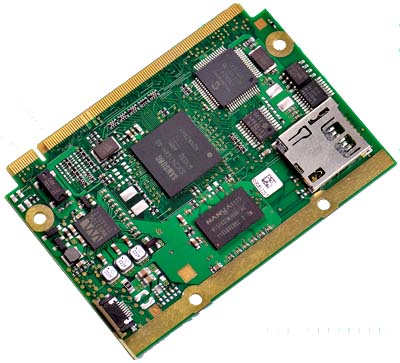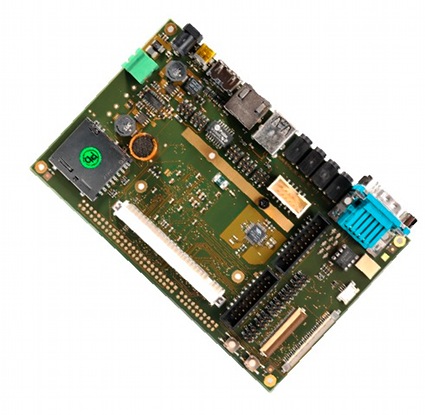Low-end ‘nanoRISC’ module has 400MHz ARM9 processor
Nov 1, 2011 — by LinuxDevices Staff — from the LinuxDevices Archive — 5 viewsMSC Vertriebs announced a 2.75 x 2-inch SOM (system on module) packing a 400MHz Samsung S3C2416 processor, up to 128MB of RAM, and up to 1GB of flash storage. The nanoRISC-S3C2146 offers 10/100 Ethernet, USB 2.0 host and client ports, multiple serial ports, plus VGA video output, according to the company.
Stutensee, Germany-based MSC Vertriebs announced its nanoRISC format at March's Embedded World show, although we were unaware of it at the time. This SOM design resembles Qseven — which MSC had employed in February for its Tegra 2-based MSC Q7-NT2 — and appears to employ the same 230-pin MXM (Mobile PCI Express Module) connector, but it's even smaller: Qseven modules measure approximately 2.75 x 2.75 inches (70 x 70mm), whereas nanoRISC modules are 2.75 x 2 inches (70 x 50mm).
MSC's initial nanoRISC-S5PC100 module employed Samsung's ARM Cortex A8-based S5PC100 processor, clocked at either 667 or 833MHz. The nanoRISC-S5PV210 announced at the end of September stepped up to Samsung's S5PV210, getting a clock speed bump to either 800MHz or 1.0GHz.

The nanoRISC-S3C2416
MSC announced a third, low-end model Oct. 31, the nanoRISC-S3C2416 pictured above. Not long after a press release was issued, the company's web server went down for the day — Halloween gremlins, perhaps? — but we can tell you that this module uses Samsung's ARM9-based S3C2416 processor.
According to MSC, the nanoRISC-S3C2416 comes with up to 128MB of RAM, up to 1GB of flash storage, and a microSD expansion slot. It is interchangeable with the other two nanoRISC modules as long as a defined minimum set of I/O interfaces is used, which allows customers to offer different performance classes in what is otherwise the same system, the company says.
MSC said its previous nanoRISC-S5PC100 module provided RGB resolutions up to 1280 x 720 pixels and HDMI resolutions to 720p (1280 x 720), while the nanoRISC-S5PV210 improved these to 1366 x 768 via RGB and 1080p (1920 x 1080) via HDMI. The nanoRISC-S3C2416, meanwhile, only supports resolutions up to 640 x 480 pixels.
Again, the little module's interfaces all need the assistance of an application-specific baseboard to reach the outside world. MSC offers its own evaluation baseboard known as the nanoRISC-MB2 (detailed later in this story).
Given that MSC' hadn't posted a product page for the nanoRISC-S3C2416 at the time of writing, we've had to extrapolate a little regarding what interfaces the nanoRISC-S3C2416 actually offers. It certainly drops the camera interface found on the other two nanoRISC modules, since the Samsung S3C2416 doesn't support one.
We combined specifications listed by MSC for its previous nanoRISC-S5PV210 with those touted for the nanoRISC-S32416 to derive the following list (but you should double-check it before ordering):
- Processor — Samsung S3C2416 clocked at 400MHz
- Memory — up to 128MB of soldered-on DDR2 DRAM and 1GB of soldered-on NAND flash
- Expansion — microSD slot onboard; 1 x MMC/SD interface
- Networking — 10/100 Ethernet
- Other I/O:
- VGA
- USB 2.0 host
- USB 2.0 host/client
- audio (AC '97, I2S, S/PDIF)
- 2 x serial
- 2 x SPI
- 2 x I2C
- CAN 2.0B
- Power — 2 Watts; 5VDC or 3VDC
- Operating range:
- 32 to 140 deg. F (commercial version)
- -40 to 185 deg. F (industrial version)
- Dimensions — 2.75 x 2 inches
nanoRISC-MB2 evaluation board
As mentioned, MSC provides an off-the-shelf baseboard so that nanoRISC customers can test the modules and begin their own hardware and software development. The nanoRISC-MB2, pictured below, measures 6.3 x 3.9 inches, giving it room for the module as well as a number of real-world connectors.

MSC's nanoRISC-MB2
Atop the board, there's an SD slot as well as headers for LVDS, RGB, and camera interfaces. The nanoRISC-MB2's coastline, meanwhile, is said to offer USB host (Type A) and On-The-Go (Mini USB) connectors, two DB9 serial connectors, an RJ45 Ethernet port, a DB9 CAN port, and 3.5mm audio jacks.
According to MSC, the nanoRISC-MB2 accepts input power ranging from 8 to 24VDC. Operating range matches that of the nanoRISC module itself, in either commercial or industrial versions.
Further information
MSC Vertriebs did not provide pricing or availability specifics, but noted that the nanoRISC-S3C2416 is available with Linux, Windows Embedded Compact 7, or Windows CE 6. More information should eventually be available on the company's nanoRISC product page.
Jonathan Angel can be reached at [email protected] and followed at www.twitter.com/gadgetsense.
This article was originally published on LinuxDevices.com and has been donated to the open source community by QuinStreet Inc. Please visit LinuxToday.com for up-to-date news and articles about Linux and open source.